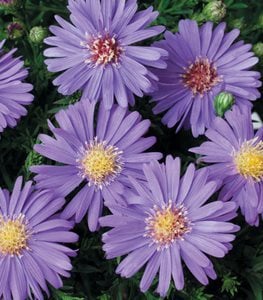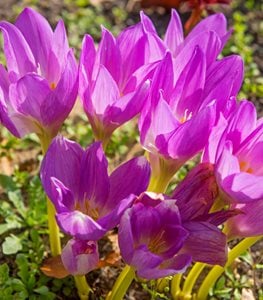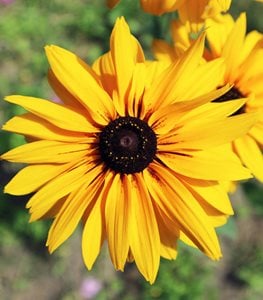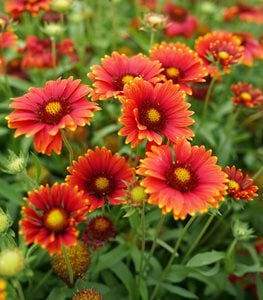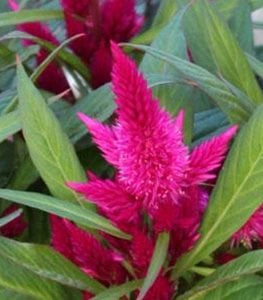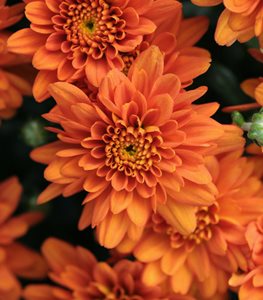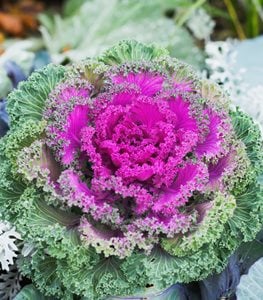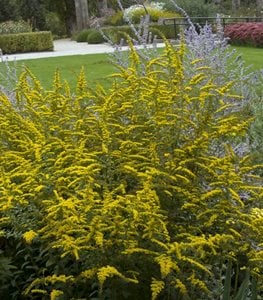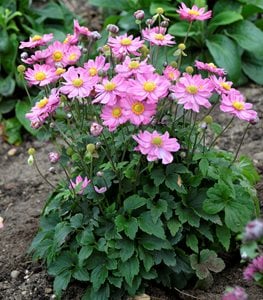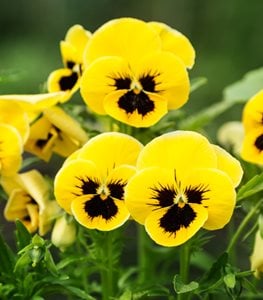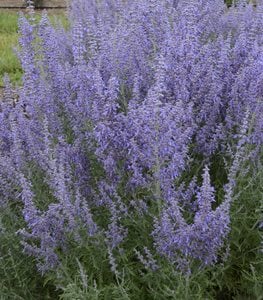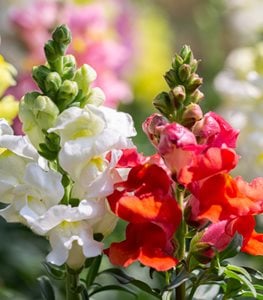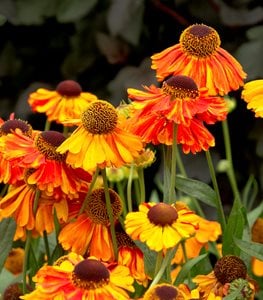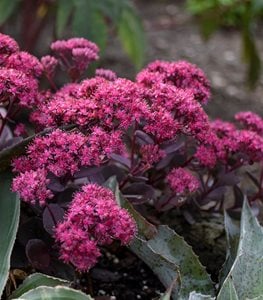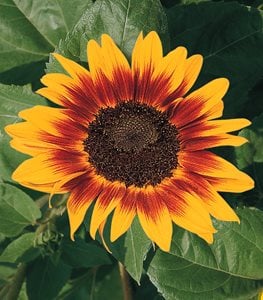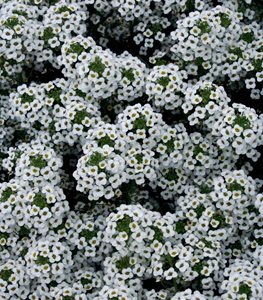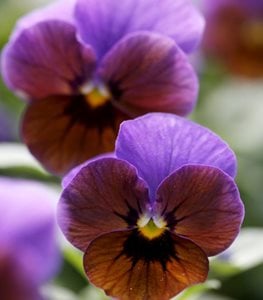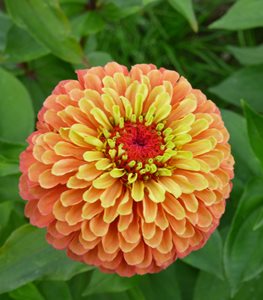The Best Flowers for Your Fall Garden
20 fall-blooming annuals and perennials that will continue to bring color, texture, and beauty to your garden well past summer’s peak.When you think of flowers for the fall garden, classic late-bloomers such as chrysanthemums and asters are sure to come to mind. But there are dozens of other showy flowering plants that can fill your beds, borders, and containers with color all the way through autumn. Some will bloom only in fall, while others will start earlier in the season and continue nonstop right up until the first frost. Even some of the cool-season flowers you planted in spring will revive with the drop of temperatures in fall and put on a spectacular repeat performance.
20 FALL FLOWERS
AFRICAN DAISY (Osteospermum spp. and hybrids)
Zones: Usually grown as an annual
Exposure: Full sun to partial shade
Bloom time: Late spring until frost
Height/Spread: 1 to 3 feet tall, 1 to 2 feet wide
Unlike the common daisy, this distant relative flourishes in cool weather and comes in a broad assortment of colors to rev up late-season plantings. Although most varieties have flat petals, some have frilly semi-double flowers or fluted petals shaped like tiny spoons.
Learn more about growing African daisy.
ASTER (Symphyotrichum spp. and hybrids)
Zones: 3-10
Exposure: Full sun
Bloom time: August through October
Height/Spread: 1 to 6 feet tall, 1 to 3 feet wide
Asters are second only to mums on the list of the most traditional perennials to plant for fall color. Their daisy-like flowers in cool shades of purple, pink, blue, and white provide a nice respite from the usual autumn color scheme. They also are an important late-season nectar source for foraging bees and butterflies.
Learn more about growing asters.
AUTUMN CROCUS (Colchicum spp.)
Zones: 4-8
Exposure: Full sun to partial shade
Bloom time: September to October
Height/Spread: 6 to 12 inches tall and wide
Although the crocus is often considered a harbinger of spring, this showy look-alike waits until fall to send up its pretty blooms. The large flowers range in color from pale purple to pure white and arise from the ground on bare stems free of foliage, which emerges and dies back in advance of the flowers in spring. If you plant your autumn crocus bulbs in the garden by late summer, they will bloom just a few weeks later.
BLACK-EYED SUSAN (Rudbeckia spp. and hybrids)
Zones: 3-9
Exposure: Full sun
Bloom time: Late July until frost
Height/Spread: From 10 inches to 7 feet tall, depending on cultivar
Few plants are easier to grow than this tough North American native, which blooms reliably from late summer into fall with a minimum of care. Although these dark-eyed beauties usually have radiant yellow blooms, some cultivars, such as ‘Autumn Colors’, display flushes of gold, red, rust, and bronze.
Learn more about growing black-eyed Susan flowers.
BLANKET FLOWER (Gaillardia hybrids)
Zones: 3-10
Exposure: Full sun
Bloom time: Late spring until frost
Height/Spread: 1 to 3 feet tall and wide
With an exceptionally long bloom time, blanket flower is one of those rare perennials that can take you from summer well into fall without missing a beat. We love the fiery reddish-orange flowers of Heat it Up® Scarlet (pictured), which has a trailing habit ideal for hanging baskets and containers.
Learn more about growing blanket flower.
CELOSIA (Celosia argentea)
Zones: Usually grown as an annual
Exposure: Full sun
Bloom time: Summer through fall
Height/Spread: Up to 3 feet tall and 1 foot wide
If you need a change of pace from the traditional fall mums and pansies, try celosia, a trendy alternative that adds marvelous texture and vertical interest to fall garden beds and containers. Celosia’s tall, feathery flower spikes come in a palette of rich colors, including dark purple, scarlet red, orange, yellow, and burgundy. And although celosia is known for its heat tolerance, it also does well in the cool temperatures of early autumn.
CHRYSANTHEMUM (Chrysanthemum grandiflorum)
Zones: 5-9
Exposure: Full sun
Bloom time: September until frost
Height/Spread: 1 to 3 feet tall, 1 to 2 feet wide
Although mums
Learn more about growing mums.
FLOWERING KALE (Brassica oleracea)
Zones: Usually grown as an annual
Exposure: Full sun
Bloom time: Grown for foliage
Height/Spread: 8 to 12 inches tall, 10 to 18 inches wide
Despite the name, flowering kale is grown primarily for its frilly foliage. When the temperatures drop in fall, the center leaves turn lovely shades of white, pink, and purple, giving the illusion of a flower in bloom. Kale partners beautifully with many fall flowers and is tougher than most of them, standing up to frosty temperatures and remaining colorful well into winter.
GOLDENROD (Solidago spp. and cultivars)
Zones: Varies by species
Exposure: Full sun
Bloom time: Late summer to mid-fall
Height/Spread: From less than a foot to over 6 feet tall and wide
This beautiful native wildflower has made its way from the prairie to the perennial garden thanks to newer cultivars with showier flowers, more compact growth habits, and longer blooms times. In addition to its ornamental value, goldenrod is an important late-season food source for fall-migrating monarchs and other pollinators.
Learn more about growing goldenrod plants.
JAPANESE ANEMONE (Anemone spp. and hybrids)
Zones: 4-8
Exposure: Full sun to partial shade
Bloom time: August through October
Height/Spread: 2 to 4 feet tall, 1 to 3 feet wide
Also called windflower because of how the flowers bob and sway in the breeze, these statuesque plants are among the most welcome sights in the early fall garden. They sport single or double flowers in shades of white, pink, or purple, all with showy yellow stamens. Even when not in bloom, this plant is striking alone for its deeply lobed foliage, which resembles small maple leaves.
In highly favorable conditions, Japanese anemone plants can naturalize somewhat aggressively.
Learn more about growing anemone flowers.
MARIGOLD (Tagetes spp.)
Zones: Usually grown as an annual
Exposure: Full sun
Bloom time: Late spring until frost
Height/Spread: 6 inches to 4 feet tall, 6 inches to 2 feet wide
Like zinnias, the marigold is another quintessential summer bloomer that transitions nicely into fall. The carnation-like flowers, usually in bright shades of orange and yellow, not only attract pollinators, they also have a pungent aroma that keeps away unwanted garden pests.
Learn more about growing marigolds.
PANSY (Viola x wittrockiana)
Zones: Usually grown as an annual
Exposure: Full sun to partial shade
Bloom time: Spring and fall
Height/Spread: 6 to 9 inches tall, 9 to 12 inches wide
The cheerful faces of pansies come in just about every color of the rainbow, including autumnal shades of orange, deep purple, and even black. Though usually grown as annuals, pansies planted in the fall are often resilient enough to survive through winter and bloom again in the spring, especially if you protect their roots with a layer of mulch.
How to tell a pansy from a viola? Four petals up, one down = pansy. Two petals up, three down = viola.
Learn more about growing pansies.
RUSSIAN SAGE (Perovskia atriplicifolia)
Zones: 4-9
Exposure: Full sun
Bloom time: Late July to October
Height/Spread: 2 to 4 feet tall and wide
With its open, airy nature and frothy blue flowers, Russian sage is an excellent filler in the fall garden, providing cool contrast to the rich, warm colors of many other fall flowers. Although the blooms begin to appear in summer, they are incredibly long lasting, often persisting for months.
Learn more about growing Russian sage plants.
SNAPDRAGON (Antirrhinum majus)
Zones: Usually grown as an annual
Exposure: Full sun
Bloom time: April until frost
Height/Spread: 1 to 3 feet tall, 6 to 12 inches wide
With their colorful blooms and tall flower stalks, snapdragons are a striking addition to the cool-season garden. The deep-throated flowers, which resemble the head of a dragon, come in a kaleidoscope of colors, including rich purple and violet shades that look stunning alongside pansies and violas.
Learn more about growing snapdragon flowers.
SNEEZEWEED (Helenium spp. and cultivars)
Zones: 3-8
Exposure: Full sun
Bloom time: August to October
Height/Spread: 3 to 5 feet tall, 2 to 3 feet wide
This brightly colored native perennial will liven up your garden through the dog days of summer and beyond with masses of daisy-like blooms in shades that echo the colors of autumn leaves. Despite the name, the flowers are allergen-free, so cut as many as you please for indoor arrangements. Sneezeweed will bloom even more profusely if you keep it deadheaded.
STONECROP - SEDUM (Sedum hybrids)
Zones: 3-9
Exposure: Full sun
Bloom time: August to frost
Height/Spread: 1 to 2 feet tall and wide
Autumn-blooming stonecrop stands out from your typical fall fare because of its thick, succulent leaves and dense clusters of star-shaped flowers that intensify in color as they mature, going from light pink to deep red. As a bonus, the dried flowerheads of stonecrop remain attractive through winter, giving you several more months of interest.
Learn more about growing sedum plants.
SUNFLOWER (Helianthus annus cultivars and hybrids)
Zones: Usually grown as an annual
Exposure: Full sun
Bloom time: Summer until frost
Height/Spread: 3 to 10 feet tall, 1 to 3 feet wide
With their cheery daisy-like blooms—some as large as 10 inches across—sunflowers have become a staple of the late-season garden. Varieties with bright yellow petals are the most common, but you can also find cultivars with red, rosy pink, orange, bronze, creamy white, and bicolored blooms. The prominent seed heads also add to the display and range in color from light green to chocolate brown.
Learn more about growing sunflowers.
SWEET ALYSSUM (Lobularia maritima and hybrids)
Zones: Usually grown as an annual
Exposure: Full sun
Bloom time: Spring until first hard frost
Height/Spread: 4 to 10 inches tall, spreading up to 4 feet
Sweet alyssum thrives in cool weather, carpeting fall garden beds with tiny honey-scented flowers in shades of white, pink, rose, and purple. They also look spectacular spilling from containers and hanging baskets, especially when paired with pansies and other colorful fall-flowering annuals. As a bonus, newer hybrids of sweet alyssum also have good heat tolerance, so you can plant them in spring and enjoy their blooms all season long.
Learn more about growing sweet alyssum.
VIOLA (Viola spp.)
Zones: Usually grown as an annual
Exposure: Full sun to partial shade
Bloom time: Spring and fall
Height/Spread: 6 to 8 inches tall and wide
Violas and their pansy cousins are among the most frost-tolerant and colorful of the cool-season annuals. Viola flowers come in a wide array of striking color combinations (see eight of our favorites) and are smaller and daintier than those of pansies. For the best blooms, wait until the cooler weather of autumn arrives before you plant them. (Violas are actually perennials that are normally grown as annuals.)
ZINNIA (Zinnia spp. and hybrids)
Zones: Usually grown as an annual
Exposure: Full sun
Bloom time: Late spring until frost
Height/Spread: Varies by type
Few flowers come in a greater assortment of colors than zinnias, from pale pastels to vivid orange, red, and purple shades that pop in the fall garden. Although zinnias are often planted in spring for blooms all summer long, they germinate from seed quickly, so you can plant them in succession through midsummer for nonstop blooms into fall. Vigilant deadheading of mature plants is another way to prolong flowering late into the season.
Learn more about growing zinnias.
TIPS FOR GETTING THE MOST FROM YOUR FALL FLOWERS
Prolong the display.
Sometimes a few strategies such as succession planting, pruning, and judicious deadheading will allow you to extend the bloom season of your favorite summer flowers into fall. Giving your plants a trim in late summer will also improve their shape and increase their vigor.
Try some tropicals.
Although it may seem contradictory, some heat-loving tropical plants thrive in the cool weather of fall. Cannas and perennial hibiscus, for example, often don’t start flowering until mid to late summer and continue blooming right up until the first frost.
Shop for late bloomers.
If you only shop for flowering perennials and annuals in spring, chances are you have a garden full of summer-blooming plants and very few that will flower in autumn. You’ll often need to make a return trip to the garden center in late summer to hunt down flowering plants that bloom late in the season.
Know your frost date.
To predict how long you might be able to enjoy your fall flowers, it’s important to know the average first frost date in your area and choose your plants accordingly. If you live in a colder climate, plant hardier frost-tolerant fall bloomers to extend the growing season as long as possible. Some varieties of pansies, such as extra-hardy Icicle® pansies, can even survive sub-zero temperatures.
(Resource: Fallscaping: Extending Your Garden Season into Autumn, by Nancy Ondra and Stephanie Cohen)
RELATED:
25 Fall-Blooming Perennials
10 Late-Blooming Flowers
21 Fall Container Ideas
Fall Gardening Tips & Chores

